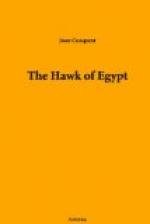She stood with her head uncovered—it is permissible at sunset—and with her face lifted, as she listened to the call to prayer, so that a sun-ray silting in through the silks blazed down upon the positively red curls which rioted all over her head and were of a tone sharper than henna, yet many times removed from the shades of red known as carrots or ginger.
Her skin was matte, her mouth crimson, and curved, the teeth perfect, and her heavily-lashed eyes of so deep a purple as to appear black. She was slim and supple, unencumbered by anything more confining than a suspender-belt, a fortnight off her eighteenth birthday and entirely lovable in looks, ways and temperament in the eyes of all mankind, which includes women.
The prayer over, and the men again about the business of the hour, she enquired her way of the vendor of silks who, having quickly replaced his shoes, had as hastily returned to his shop, his heart rejoicing at the prospect of perhaps one or two hours’ more bargaining—for where is to be found the Oriental who knows the value of time?
Loving animals, Damaris wanted to find that corner near the silk-market where can be purchased anything from a camel to a hunting cheetah, a greyhound to a falcon.
It is not wise for European women to saunter about the old Arabian quarter unaccompanied, especially if they have been blessed by the gods in the ways of looks. Damaris Hethencourt most certainly ought not to have been there, but you must perforce follow the path Fate has marked out for you, whether it leads through country lanes, or Piccadilly, or the Arab quarter of Cairo.
The vendor of silks salaamed deeply before her beauty and the graciousness of her manner, for she smiled when she talked and spoke the prettiest broken Arabic in the world.
So, putting the huge two-year-old bulldog, which one day was to claim the proud title of champion, on the leash, she wended her way through the narrow streets in which two camels may scarce squeeze past each other and where the masharabeyeh of the harems almost meet overhead.
Water-carriers, camels, sweetmeat-sellers; lowly women in black gown and yashmak; coffee-sellers; donkeys which continually bray and dogs which unceasingly bark; cracking of whips; shrill cries of “Dahrik ya sitt or musyu,” ("Thy back, lady, or sir"); shouts of U’a u’a; clashing of bronze ware; snarls of anger; laughter; song; dust and colour, all the ingredients which go to the entrancement of the bazaar.
And the odours?
Scent and perfume, aroma and odour; cedars of Lebanon and harem musk; tang of the sandy sea, fume of the street; the trail of smoke and onions; the milk of goats; the reek of humanity; the breath of kine. Make a bundle of that, and tie it with the silken lashes of women’s eyes; secure it with the steel of a needle-pointed knife—and leave it at that.




